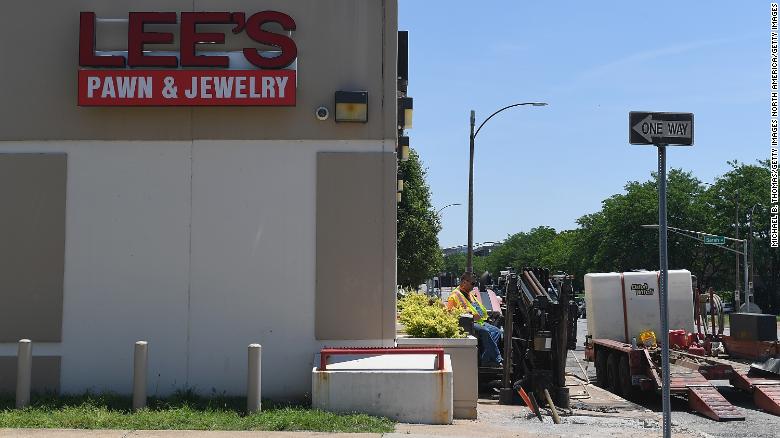How globalization became sinicization
Americans Won’t Live in the Pod

Blue-city urbanization imposes a downward mobility people don’t want and don’t need.
“No Bourgeois, No Democracy”
– Barrington Moore
Protecting and fighting for the middle class regularly dominates rhetoric on the Right and Left. Yet activists on both sides now often seek to undermine single-family home ownership, the linchpin of middle-class aspiration.
The current drive to outlaw single-family zoning—the one protection homeowners possess against unwanted development—has notched bans in the City of Minneapolis and the state of Oregon, with California not far behind. Advocates have tapped an odd alliance of progressives and libertarians. Essentially, it marries two inflexible ideologies, in principle diametrically opposed, but neither of which see housing as a critical element of family and community. In its stead, the Left seeks to place the state in charge, while libertarians bow instinctively to any de-regulatory step they see as increasing “freedom and choice.”
Although couched in noble sentiments, both approaches are fundamentally hostile to both middle- and working-class aspirations. Without a home, the new generation—including minorities—will face a “formidable challenge” in boosting their worth. Property remains key to financial security: Homes today account for roughly two-thirds of the wealth of middle-income Americans while home owners have a median net worth more than 40 times that of renters, according to the Census Bureau. Equally important, a shift from homeownership would also weaken the basis of democracy. Since ancient times, republican institutions have rested on the firmament of dispersed property ownership.
An Odd Time for More Density
The push for ever-greater density and against suburban homeownership could not come at a less propitious time. Even before the pandemic, big cities like New York, Los Angeles, and Chicago were losing population. Since 2010, despite all the talk of a massive “return to the city,” suburbs and exurbs account for about 90% of all metropolitan-area growth. Millennials, often seen as an urban generation, have fueled population growth in the suburbs since 2010.
Millennials have had a hard time buying homes—among post-college millennials (25-34), ownership has dropped from 45.4% in 2000 to 37.0% in 2016, a drop of 18% according to Census Bureau data—but three-quarters want single-family detached houses, according a 2019 report on home buyer preferences by the National Association of Homebuilders. A 2018 Apartment List survey found that 80% of millennials dream of home ownership. Among those under 35 who do buy homes, four-fifths choose single-family detached houses.
This shift has been greatly accelerated by the pandemic, and could gain even more momentum from the rising crime and disorder in many of our core cities. Pew reports roughly one in four Americans either moved on account of COVID-19 or knew someone who did so, with the largest percentages for young people under 30. Since 2018, according to Gallup, the percentage of Americans saying they want to live in cities dropped 55%, down to barely 13%. Rather than the much-ballyhooed “back to the city” movement, we are entering what Zillow describes as “a great reshuffling” to suburbs, smaller cities, and less expensive states. Even non-metro areas, for the first time in over a decade, are beginning to gain population.
The rise of online work is likely to accelerate the trend. Stanford economist Nicholas Bloom projects we will see telecommuting increase from 5% of the workforce before the pandemic to something closer to 20%. More important still, most people now working from home express a preference—some 60% according to Gallup—to do so for the foreseeable future. Even when offices opened early this summer in New York, real estate brokers report, most workers refused to return. And now developers, like KB Homes, are adding home offices to their newest offerings.
These trends will be reinforced by shifts in job markets. A new survey by the Site Selectors guild suggests that only 10% of companies are looking to expand in large cities, one sixth as many as choose suburbs, and a third of those who favor rural areas. Meanwhile major office and residential complexes are being downsized, cancelled, or hit with major price reductions in cities from Chicago and New York to Los Angeles and San Francisco.
Seeking the Soviet Dream
High-density housing was long the reigning ideology in the Soviet Bloc, where, as the authors of The Ideal Communist City suggested, people might prefer a single-family house—providing “ideal conditions for rest and privacy” but violating the socialist ideal of a society in which solidarity and equality of conditions, not individual aspiration, were priorities.
Today’s progressives, like the University of California’s Victoria Fierce of the YIMBY pro-density lobby, also embrace density, in part because it promotes collectivism. They also tend to see urban cores as the forge for social justice, although, as a recent MIT report demonstrates, our core cities now suffer a level of inequality far worse than that of the countryside or suburbs and more resembling social conditions in Mexico.
Yet even as the next generation disperses outward, many Democrats seem to want to change the periphery to more resemble urban areas. During President Obama’s second term, HUD suggested imposing density on suburbs as a way to integrate neighborhoods, even without any evidence of discrimination. Progressives in California, Oregon, and Minnesota have all pushed bans on single-family zoning, painting single-family houses as racist and unecological. Some, like Vox’s Matthew Yglesias, blame single-family zoning for high prices and label suburbs as “centrally planned sprawl.”
The assault on suburban construction and single-family housing has been a major factor in driving median house prices in the coastal California metropolitan areas (Los Angeles, San Francisco, San Diego, and San Jose) to as much as 350% more than the national average, according to the 2019 American Community Survey. Median gross rents, which tend to follow house prices, are from 50% to more than 100% higher than the national average in the same metros.
It is hard to imagine public policies more disadvantageous to the aspirations of black and Hispanic families. What decade do these people think we are living in? Even in deep-South Atlanta, more than 70% of blacks and Hispanics live in the outer suburbs, where single-family housing predominates. Further, in the 53 metropolitan areas with more than 1,000,000 residents, more than two-thirds of blacks and Hispanics now live in suburban areas, where the houses are overwhelmingly single-family.
Blue city planning regimes have helped raise prices so barely one-third of African Americans own homes in Los Angeles, Boston, and New York. In Atlanta that number reaches nearly 50%; in Charlotte and Nashville, nearly 45%. Latino home ownership exceeds 50% in Houston and Dallas-Fort Worth but is below 30% in New York and Boston.
The climate change gambit, the raison d’être for regulatory excess in California, is equally absurd. The total result of forced densification—built around transit hubs—would be, as a Berkeley study admits, insignificant. Rather than stop “sprawl,” opposition to development of new, denser suburbs has led to a massive increase in super-commuters, who often travel as many as 90 miles to work. Oddly the state has little interest in the rise of online work. Super-commuters can reduce their driving as well as their greenhouse gas emissions by working at home in the suburbs. Meanwhile, blue city planners want urban apartment dwellers at all costs.
Libertarian Delusions
Unlike progressives, libertarians worship not at the altar of sustainability and égalité but that of “market forces.” To some, any deregulation, despite ignoring the critical role of the periphery, is inherently a good thing. Like their progressive paramours, conservatives like Austin Bramwell, writing in the retro-Right American Conservative, also blame “sprawl” on a “seemingly intractable network of government regulations, from zoning laws and building codes to street design regulations” (emphasis added).
As analyst Randal O’Toole has shown, the libertarian Right tends to dismiss the fact that people might actually want to live a certain way, and naturally seek to protect it. So Reason, often a very perceptive magazine, comes out supporting a law that eliminates single-family zoning in San Francisco and other unaffordable California cities. Another Reason writer endorses a new zoning ordinance in Minneapolis that allows multifamily housing in single-family neighborhoods. The libertarian Mercatus Center blames high housing prices on single-family zoning, as does a report from the Cato Institute.
Libertarians, wedded to theory, and in some cases sharing with progressives a disdain for the suburban lifestyle, generally miss that the fundamental cause of higher house prices lies with the hyper-escalation in land prices largely attributable to urban containment policy. Although NIMBYs can be a factor, the land shortage created by urban containment is the very foundation of California’s inability to deliver attainable homes for middle-income households. With these artificially high land prices, the only way to provide sufficient supplies of housing is massive state and local subsidies, well beyond the political will of the electorates or the resources of government.
Backers of legislation to ban single-family homes, such as the controversial SB-50, naturally have generous and wealthy real estate allies, eager for the opportunity to transform prospective owners into a “rentership society,” where people remain renters for life, enjoying their video games or houseplants. Bills like SB-50 also win the support of Silicon Valley oligarchs who see state-provided housing subsidies as well as unconditional cash stipends as a handy means to keep future peasants from rising against their betters.
Some suggest that by stopping zoning we should follow the regulatory regime of Texas, and particularly Houston, which has created far less expensive housing options. Yet few of the Houston fans—of which I am one—recognize the role of “covenants” that allow homeowners to choose areas effectively restricted to single-family homes. More critically, almost all the growth in the region now takes place in the suburban stretches of Harris and surrounding counties, where new housing is built in planned developments with municipal utility districts, such as Cinco Ranch or the Woodlands, or in municipalities, some that have zoning for both single- and multi-family housing.
Fundamentally, Texas keeps the price of homes reasonable by building more of them. As research in Canada has shown, areas that build more single-family homes are far more affordable than those that don’t. This is what places like California do not do. Proportionally per 1,000 residents, ten times as many single-family houses were built over the past decade in Nashville, Austin, and Raleigh as were built in Los Angeles. You do not have to be Milton Friedman to know that more supply of a wanted product might keep the price down.
YIMBY activists, including many Libertarians, naively assume that just increasing housing supply will materially improve housing affordability. But given current land costs and regulatory restraints in many states, the bulk of new multifamily construction nationwide tends toward expensive smaller units, no solution to the needs of young families entering their 30s. As urbanist pundit Richard Florida suggests, along with economist Tyler Cowen, there is little evidence that allowing more construction in cities helps affordability; it is more likely that the winners of urban de-regulation will be landlords and developers, not local working- or middle-class populations.
California’s hotly contested Weiner Bill, which would have allowed fourplexes on virtually any parcel no matter local preferences, appealed to many free-market libertarians, even in markets already rigged by urban containment policies and other cost-increasing regulations. Critically, it was opposed not only in affluent suburbs, widely blamed for SB-50’s defeat, but in the stable majority-black or Hispanic urban neighborhoods of east and south Los Angeles. Both Los Angeles and San Francisco city governments, no slouches in reflecting minority sentiment, strongly opposed SB-50.
The Ownership Order
Today’s odd coupling of libertarians and collectivists—backed by urban real estate interests—may seem mighty indeed, but it will have to overcome powerful grassroots opposition. To be sure, a recent Rasmussen poll found that close to 80% of adult Americans oppose the idea of letting Washington control local zoning for social engineering.
It is more than lifestyle preference at stake here. From the early days of democratic Greece and republican Rome, dispersed property ownership was seen as the bulwark of self-government. The American founders understood the role of small property owners in developing democracy in not only ancient Athens and the Roman Republic but 17th-Century Netherlands. Those who own something—a house, a farm, a small business—are far more assertive in protecting their particular rights and far more engaged in their communities.
Until recently, most Americans, Right and Left, supported the notion of suburban expansion and greater homeownership. A tradition favoring greater ownership and opportunities has been a feature of both political parties, from the days of Jefferson and Jackson to Lincoln’s Homestead Act, the New Deal mortgage guarantees, the G.I. Bill and, long overdue, laws abolishing the enforcement of racial, religious, or ethnic barriers to housing. “A nation of homeowners,” President Franklin D. Roosevelt believed, “of people who own a real share in their land, is unconquerable.”
Sadly, Roosevelt’s political heirs have increasingly abandoned this notion, and see little good in people becoming more economically independent. At the same time, conservatives who back attempts to squelch homeownership are serving as unconscious boosters of socialism. Survey data among millennials—the group most affected—already shows a substantial shift toward support for socialism. In the Texas Democratic primary, voters over 65 went for Biden nearly four to one, according to Washington Post exit polls. By contrast, among voters under 30 Sanders cleaned up, beating Biden 58% to 13%. In California he did even better. By 2024, these Millennials will be by far the majority of Democratic voters.
Millennials—about 44% racial or ethnic minority—have good reasons to lean toward socialism. In contrast to their parents, Millennials, according to a recent study by the St. Louis Fed, are in danger of becoming a “lost generation” in terms of wealth accumulation. In a country whose mythology disdains the power of inherited wealth, millennials increasingly count on inheritance for their retirement at a rate three times that of the boomers. Among the youngest cohort, those 18 to 22, over 60% see inheritance as their primary source for wealth as they age. No surprise those who did not win the DNA sweepstakes might see socialism as a reasonable option.
Ultimately both progressives and libertarians seem determined to undermine the social basis for both capitalism and democracy. As we create a neo-feudal system dominated by the few, it will generate a politics that, whether of a socialist or capitalist color, boils down to a race between parties to appease the modern-day peasantry—who, having nothing, will grow ever less inclined to guard the property rights of others. Only a policy agenda that recommits to creating new opportunities for ownership, largely by building on the urban fringe as well as underutilized commercial areas, can reverse this trend over time.
The American Mind presents a range of perspectives. Views are writers’ own and do not necessarily represent those of The Claremont Institute.
The American Mind is a publication of the Claremont Institute, a non-profit 501(c)(3) organization, dedicated to restoring the principles of the American Founding to their rightful, preeminent authority in our national life. Interested in supporting our work? Gifts to the Claremont Institute are tax-deductible.
American institutions are unwinding.
This side of heaven, there is only one remedy for tribalism.
Woke aggression won’t stop with speech.
Our Covid-era oligarchs are fitting us for feudalism.
A new class of overlords are making their bid for world domination.






